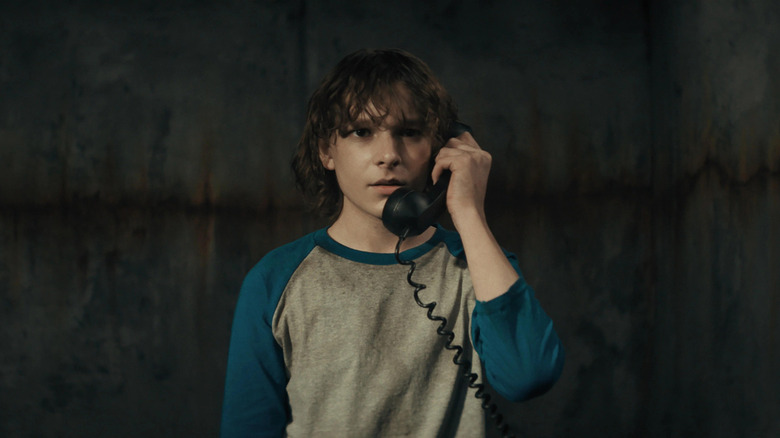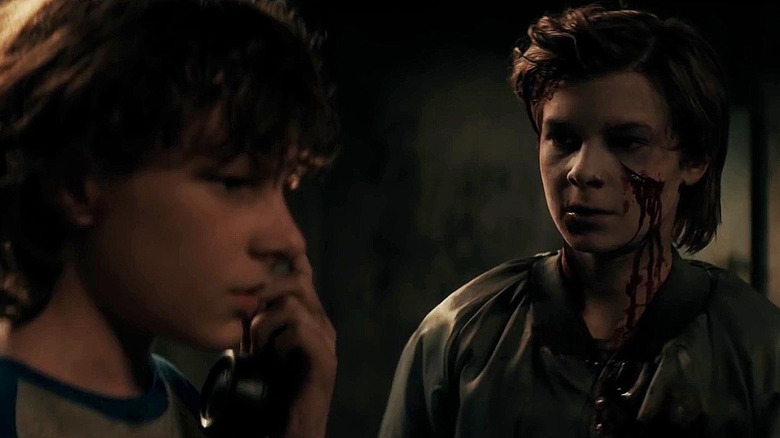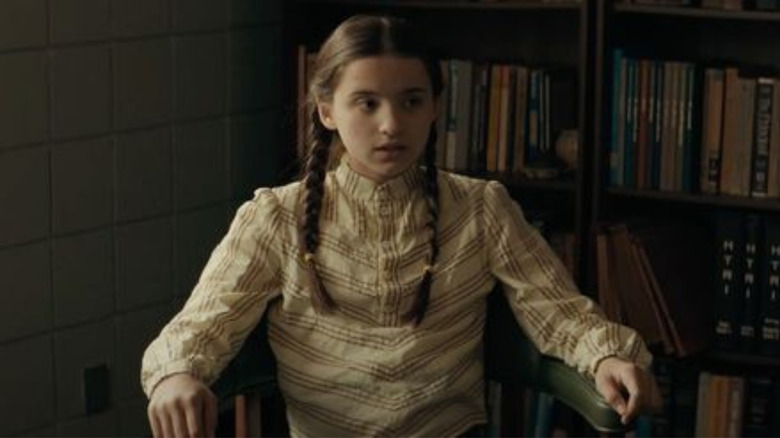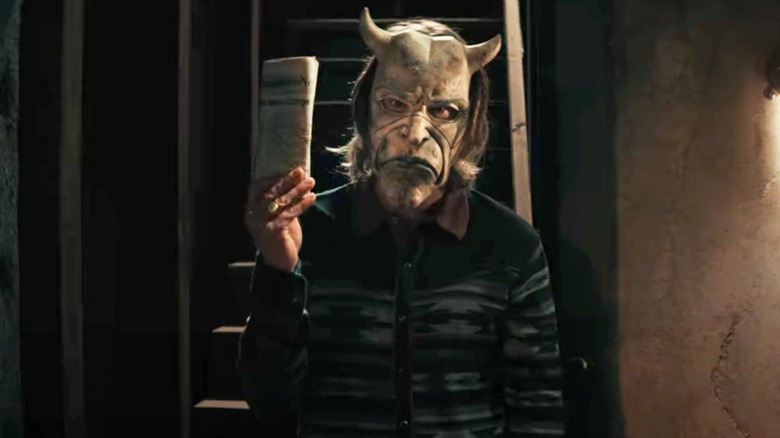The Black Phone: Every Significant Change And Addition From Page To Screen
Note: This article contains major spoilers for "The Black Phone."
After a slew of festival appearances and more than its fair share of Covid-related delays, Scott Derrickson's return to horror is finally in theaters. "The Black Phone," an adaptation of Joe Hill's 2004 short story of the same name, centers around a boy named Finney (Mason Thames) trying to escape the grasp of the sinister kidnapper only known as the Grabber (Ethan Hawke). The catch? He's going to need the help of the spirits of the Grabber's previous victims if he wants to accomplish this.
The original story, which can be read in its entirety here, is a brisk but chilling read, leaving things just vague enough for the reader to draw their own conclusions. Derrickson's adaptation, which he co-wrote with frequent collaborator C. Robert Cargill, is decidedly less so, adding in several changes to streamline and clarify the original material. Thankfully, the vast majority of these changes work to deliver a genuinely tense but still affirming experience. Here are some of the major ones made in the process of adapting a 30-page short story to a full-length feature film.
The spirits and the purpose of their calls
The spirits that contact Finney through the disconnected phone in the basement have their roles significantly expanded in the film. In the original short, there are four victims that Albert has claimed, but only one, a baseball pitcher named Bruce Yamada, is given an actual role in the story. When the spirit of Bruce calls Finney through the phone, he advises him to pack the phone full of dirt from the floor in order to attack Albert.
However, the film extends the presence of the spirits and their aid quite a lot, a decision that makes the tension and importance of Finney's escape that much more palpable. Bruce (Tristan Pravong) is directly adapted from the short for the film, but he is joined by other victims: tough-guy Vince (Brady Hepner), paperboy Billy (Jacob Moran), first victim Griffin (Banks Repeta), and acquaintance Robin (Miguel Cazarez Mora), who had advised him earlier in the film on how he needs to stand up for himself. The reasoning behind these calls is clear. These children tried and failed to escape, but are hopeful that Finney is the one who can.
The spirits all give Finney the techniques they tried to use to escape before they were killed, hoping that he will be the one to finally make them possible. Turns out, a combination of all their advice eventually culminates in Finney's eventual defeat and killing of the Grabber, allowing the spirits to be avenged.
A bigger emphasis on the psychic elements
Outside of Finney's capture and subsequent quest for survival, the secondary plot of "The Black Phone" revolves around his sister, Gwen (Madeleine McGraw). She appears to be his younger sister in the film, contrasting the older sister named Susannah from the original story. The short implies that Susannah, a practitioner of "occultish ideas," has some sort of psychic connection with Finney that allows her to have a loose idea of where he is. However, it is intentionally left vague as to whether she actually has these abilities.
The film adaptation leaves no such ambiguity. Gwen has had strange dreams ever since the Grabber began terrorizing their Rocky Mountain neighborhood, and these dreams weren't just regular ones. They contained explicit details about the lives of the Grabber's victims as well as the Grabber himself, leading to her gaining the respect of local detectives Wright (E. Roger Mitchell) and Miller (Troy Rudeseal). Furthermore, Gwen is seen attributing her abilities to God by praying and asking for help, rather than her believing they are the product of the occult.
According to their father Terrence (Jeremy Davies), Gwen's dreams also were apparently similar to those experienced by her mother, who we later learned died by suicide. Comparing Gwen's ability to mental illness could have been better executed than it was in the film, but thankfully, the film ensures the viewer that her dreams are real.
Almost everything about the Grabber
By far the biggest changes made for the film involved its central villain. The Grabber is a vastly different character than the story's kidnapper, Albert. For starters, he is never given a name other than the Grabber and, as previously discussed in our interviews with Hill and Cargill, is now a magician instead of a clown, wearing different devil masks to obscure his identity. This doesn't change the way that he actually kidnaps his victims, but it does make the presence of those damn balloons eerier.
The two characters also have very different appearances. The Grabber of the film is a broad but slender man with a well-kept head of hair, while the short story really wants you to know that Albert is fat, pimply, and bald. Not just any fat, "but grotesquely fat." Seriously, the word "fat" shows up 34 times across 30 pages. Serial killer or not, that's a bit excessive. It gets pretty annoying and needless after the first ten mentions, so forgoing all that description and replacing him with a slimmer, more dad-bod-like Grabber was definitely the right call.
Some aspects, such as lines of dialogue, have been kept intact. Most obviously is the presence of the Grabber's brother, named Max (James Ransone) in the film, who is completely unaware of why his brother insists that he shouldn't go into the basement.
If you want to see what other, albeit more minor details have been made, check out "The Black Phone" in theaters now.



